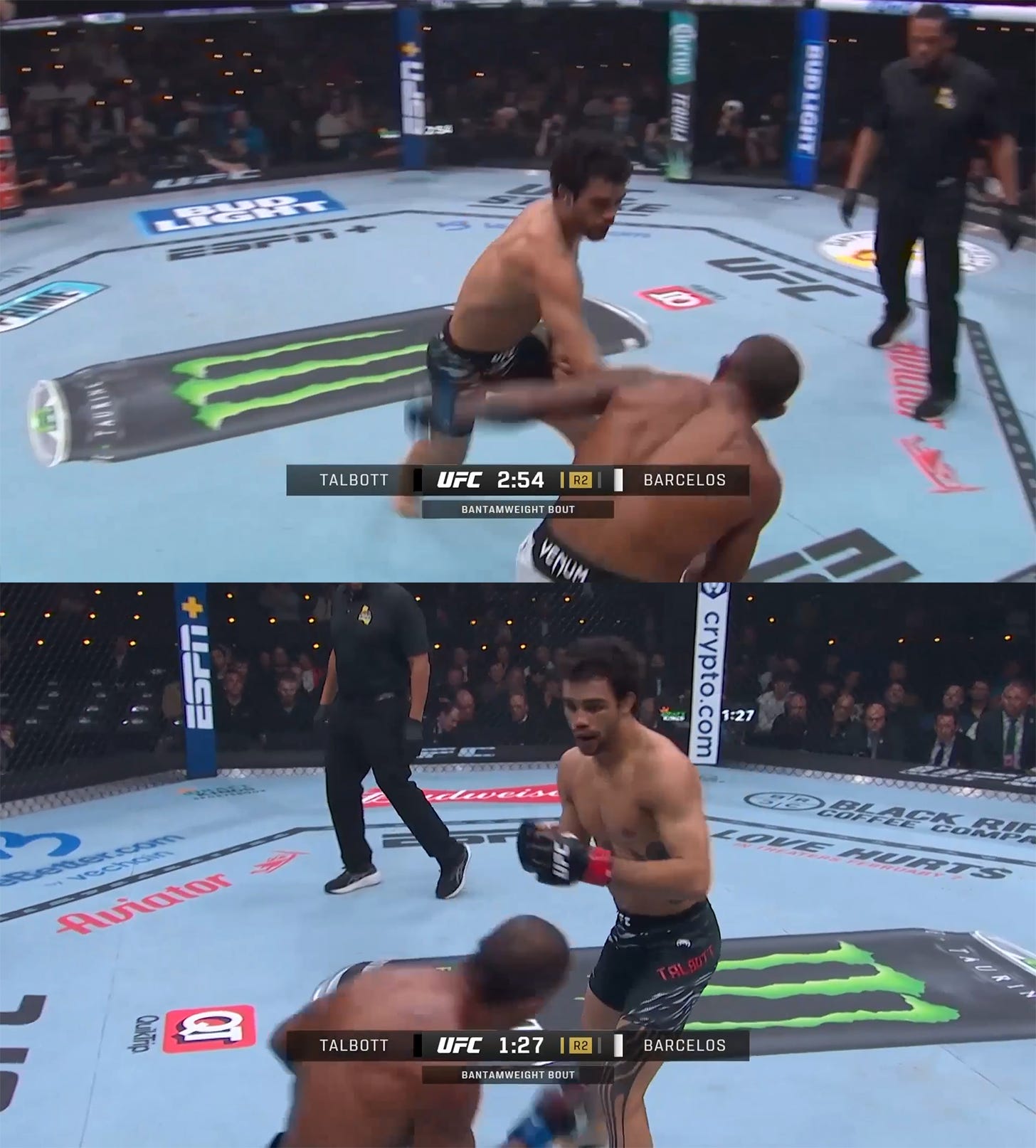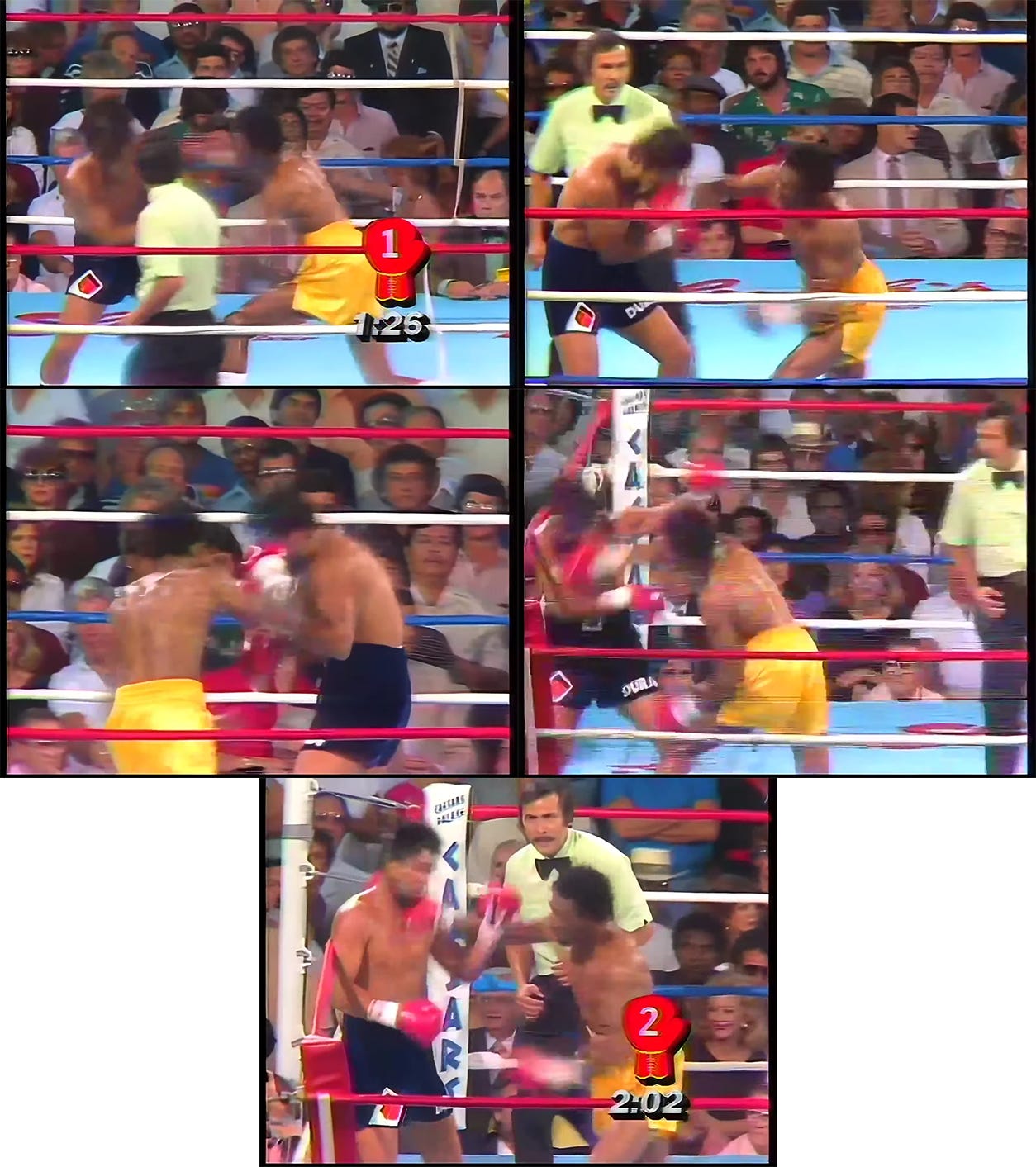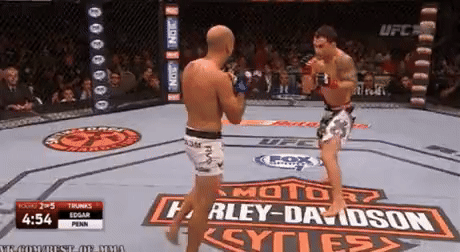- Joined
- Apr 27, 2015
- Messages
- 807
- Reaction score
- 705
What Charles Oliveira and Tommy Hearns can teach Payton Talbott about using reach effectively.
After Payton Talbott gave up a dominant round to the wrestling and top control of Raoni Barcelos, the commentary booth brought in guest analyst, Din Thomas, to explain what he was doing wrong. Often these spots wind up accidentally funny as the guest repeats what the commentators just said a moment ago, or something exciting happens and they all shout over him. But Thomas had something insightful and topical to say, pointing out that Talbott was “standing too tall as he’s trying to walk Barcelos down” and presenting “too much surface area to shoot on.”What did he mean by that? Before we get into the problems with Talbott’s stance, I want to draw your attention back to Felipe Lima’s December fight with the shorter Miles Johns. I called out after the fight took place how Lima’s willingness to bend his knees and change levels aided him in fending off the shorter man’s bursts of offense.
Lima consistently dipped beneath the punches of his shorter foe, not only keeping him safe, but putting him in a stable, athletic stance where he could quickly respond to any threat. His level changes gave him access to dipping jabs, body counters, and importantly, afforded him a low base from which to defend takedowns. If Johns chose to shoot on any of these rushes, even if he succeeded in getting underneath Lima’s center of gravity, he would be faced with a set opponent not easily moved, perched to quickly push off the ground and hip in to stuff his takedown attempt.
Keep Lima’s level changes in mind as we walk through what went wrong for Talbott on the feet.
The Height/Length Tradeoff
Fighters will often adopt a style that maximizes and accentuates their natural attributes. Powerful punchers want to apply their power quick and hard, while long fighters look to leverage their reach advantage. But fighting long isn’t exactly the same as fighting tall, even if they’re often conflated. While standing up tall can provide certain advantages to a kicker on the outside or to the taller man in the clinch, the benefits of standing up tall in the pocket are vastly outweighed by the drawbacks.The most obvious advantage to assuming a slight bend in the knees is leverage. Imagine a contest of Sumo rikishi trying to push each other out of the dohyō, where every variable but stance is equal. Would you place your money on the one standing up straight as an arrow, or the one squatting low?
Standing up tall makes it easy for shorter opponents to get underneath you and push you back from a place of superior leverage, while bending the knees mitigates that threat. Bending the knees also keeps you in a strong, balanced stance in which your legs work to absorb some of the impact of strikes, while standing up tall leaves your head taking most of the impact with nothing to cushion it.
“But wait,” you might say, “doesn’t fighting tall still maximize your reach?” Well, not necessarily. Punches are at their longest when they extend straight out from the shoulder. Any slight adjustment above or below shoulder-level shaves length off the blow.
This can be especially dangerous for taller men, as punching down not only sacrifices reach, but it also removes the shoulder from the chin, exposing it to the overhand counters that an astute shorter opponent is likely looking for. It’s in the interest of the taller man to bend his knees so that his shoulders are level with the line of his opponent’s face if he wants to maximize a reach advantage, and if he wants to remain set to meet takedown attempts with force.
Another disadvantage of standing tall in the pocket is that it obscures the vision of the taller man. His entire body is visible to his shorter opponent, but the opponent’s lower body is hidden underneath head and shoulders. Without an immediate line of sight to his lower body, it is more difficult to determine his next move, making his attack less predictable.
Payton Talbott’s willingness to stand tall in punching range left him subject to all these downsides and more.
What Went Wrong for Talbott?
Talbott spent most of the fight standing tall and narrow, nearly locking out his knees at times. Whenever Barcelos moved to change levels and threatened a takedown, he would need to make a big reaction, suddenly widening his stance and getting low to follow Barcelos.That proved to be an issue due to Barcelos’ frequent feints. He would show level changes to draw that big reaction out, or dip low and punch high, keeping the takedown threat a persistent weapon even when he wasn’t pursuing it. Since Talbott had to sell out so hard in response every time, those reactions quickly dulled and he came up slow on the real shots.
After spending most of the first round on the bottom, Talbott adjusted well to pour on the pressure and keep Barcelos moving backwards. But as Thomas pointed out on commentary, he would pursue Barcelos into punching range standing up tall and end up surrendering his advantage. With Barcelos consistently dipping, changing levels, and moving his head on the inside, and Talbott neglecting to meet him, he was left with two main responses - either punch down at the shorter man, or stand upright and watch as he dips down.
Even when Talbott could force Barcelos into shooting predictably without setup, he was rarely in position to punish him as he had to make such a sharp movement just to keep up. Barcelos was able to use his rushed shots to buy space and force Talbott onto the defensive.
The image below illustrates the issues with Talbott’s reactions to the level change:

In the first slide he’s punching down at a crouched Barcelos, exposing his chin in an exchange while still risking Barcelos getting underneath him. In the second slide, he lets Barcelos dip down near hip level before reacting, guessing that he’s not going to shoot a double leg or pop up with a right hand.
To Talbott’s credit, he did manage to stun Barcelos by catching him with an uppercut as he changed levels, but that was a failed gambit over the course of a 15-minute fight. Even uppercut counters benefit from a level change here, as pitching them from an upright posture at a crouching opponent looking for takedowns is only as good as one’s ability to differentiate the fakes from the real thing. If the uppercut is swung at a feint, the hips open up even more and the weight is thrown out of a strong defensive stance. But if their level change is met in a set stance, the lead shoulder remains in place to block on contact while the rear uppercut can still sneak in.
Barcelos was able to capitalize on Talbott’s willingness to swing upright at close range, hitting a few key reactive takedowns that bought him minutes of dominance on top:
All Barcelos has to do here is predict when the strike comes and change levels. With Talbott’s posture exposing his hips and his weight transferring into the blow, away from defending the takedown, it practically finishes itself. The second clip here is quite a clever bit of wrestling by Barcelos - Talbott’s right hook sticks his weight on his lead leg and leans him past his center of gravity. Finishing a standard double leg here would mean working against his weight to force him back the opposite way, but he’s a sitting duck to a head inside knee tap that keeps his weight stapled on that leg and forces his upper body past it. Chad Mendes was a master of finishing reactive takedowns to the head-side in similar situations.
To look at how a master exploits a height and reach disparity, let’s take a look at Tommy Hearns’ fight with Roberto Durán. Hearns is one of the best long men to ever lace up the boots or don the requisite gear of his respective combat sport, while Durán is one of the very best pocket operators in boxing history. Durán was particularly skilled at drawing out and getting underneath his opponent’s jab with body counters, but he struggled greatly to get underneath Hearns and exploit the taller man’s jab.
It’s a short fight, lasting only a minute into the second round as Hearns make quick work of Durán, so you might as well watch the whole thing. While you do, pay attention to how Hearns manages his level and posture. He spends a great deal of the short fight bending his knees or crouching down to keep his shoulder right in line with Durán’s head, maximizing the reach of his jab.
Hearns isn’t just changing levels reactively in response to Durán though, he’s constantly mixing in his own proactive level changes which serve to dissuade Durán’s. If the taller man is standing up and flinging his jab out, you just need to pick the right moment to duck. But if he’s keeping his jabbing shoulder in line with your head, it remains a constant threat, and jabs to the chest threaten to spear you on the chin if you dip down lower.
Ironically, it was Hearns who was able to consistently get underneath the shorter Durán, hurting him over and over with a right hand hidden behind level changes and a rising jab. Staying low when springing or feinting into his jab kept Durán from comfortably countering underneath, and Hearns would crouch even lower to jab the body or jab upwards at the head, straightening Durán up for the killshots.
Hearns is known for a chopping right hand that travels downwards, but even his chopping right wasn’t reaching down for Durán, but rather traveling straight out from his shoulder before sending all that power down into him. Take a look at the stills below:

Each time Hearns hurt Durán with his right hand, it was with his shoulders level to the head. The chopping form let him sneak his gangly arms in at close range and stitch it onto his jab a half-beat sooner than a typical right hand, but it was his legs and body that matched the shorter man’s level rather than the trajectory of his punch. Note also that Hearns’ level change jabs and right hands put him in a much stronger position to defend a takedown than Talbott’s offense. The low lead shoulder that blocks Durán from getting underneath him would also help fending off a takedown, and those snappy right hands leave him with a wide base to push off and resist a reactive shot.
While Talbott mostly got in trouble advancing onto reactive takedowns, he also showed a few bad habits typical of tall men when pressed. When Barcelos applied some unexpected finesse in an exchange or struck in layers, Talbott found himself caught off guard, forced to rushed his reaction. And since he tended to remain bolt upright in those exchanges, his weight would naturally fall back on his heels, taking him out of a strong stance.

